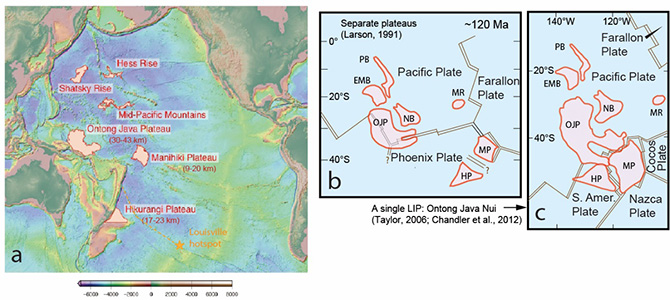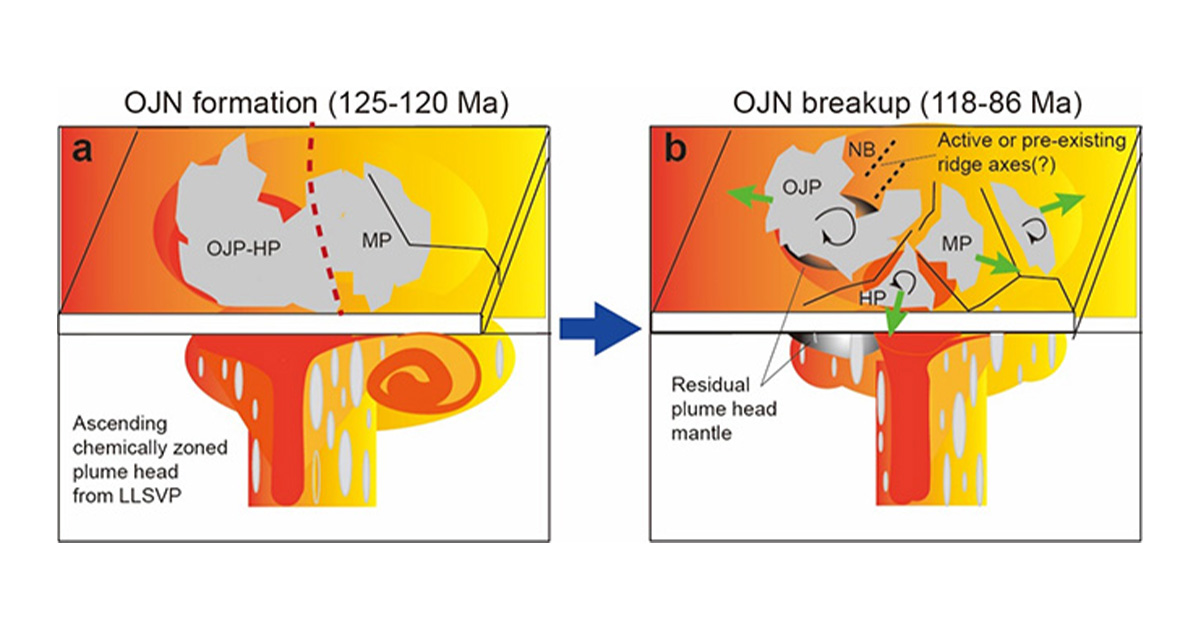JAMSTEC researchers, Maria Luisa Tejada, Takeshi Hanyu, Takashi Miyazaki, Qing Chang, and Bogdan Vaglarov of the Research Institute for Marine Geodynamics and Kenji Shimizu of the Kochi Institute for Core Sample Research, in collaboration with scientists Takashi Sano and Kenichiro Tani from the National Museum of Nature and Science, Masao Nakanishi and Shoka Shimizu of Chiba University, Akira Ishikawa of Tokyo Institute of Technology, and Anthony Koppers of Oregon State University, USA, have discovered new links between the inferred fragments of a super oceanic volcano called the Ontong Java Nui, in the Pacific Ocean.
These findings present a breakthrough for the Ontong Java Nui hypothesis.
Key Points
- Geological survey and sampling conducted in the Eastern Salient of the Ontong Java Plateau, where the proposed Ontong Java Nui super plateau fragments (Ontong Java Plateau, Manihiki Plateau, and Hikurangi Plateau) were conjoined, provide new geochemical and age data supporting the Ontong Java Nui hypothesis.
- Volcanic rocks having compositions previously found only on Manihiki Plateau were recovered from Ontong Java Plateau for the first time and new ~96-116 Ma and 67-68 Ma eruption ages bridge the temporal gap between Ontong Java Plateau and Hikurangi Plateau.
- The results indicate that OJP, MP, and HP, have a common source and that variation in composition may be explained by a chemically zoned mantle from the seismically anomalous region at the core-mantle boundary, with entrained lower mantle and recycled materials.
The Ontong Java Nui hypothesis, which puts together three largest oceanic plateaus in the Pacific, the Ontong Java Plateau (OJP), Manihiki Plateau (MP), and Hikurangi Plateau (HP) as one super volcanic edifice 120 million years ago was first proposed in 2006. However, the hypothesis has been debated given the few evidence and many unresolved issues. For example, the three plateaus differ in crustal thickness, there is a gap in the composition between MP basalts and OJP basalts, and the main stage emplacement of both OJP and MP are apparently older than HP.
 a) Present-day location of the Ontong Java Plateau (OJP), Manihiki Plateau (MP), and Hikurangi Plateau (HP) in the Pacific Ocean. Crustal thicknesses of OJP, MP, and HP are indicated by red numbers. Also shown is the Louisville hotspot (orange star) believed to be the plume mantle source of the OJP. b) and c) Two model projections back to their location 120 million years ago as separate volcanic platforms after Larson (1991) and as one super plateau after Taylor (2006), which is later known as the Ontong Java Nui after Chandler et al. (2012). Also labeled are surrounding basins and rises: PB= Pigafetta Basin; EMB= East Mariana Basin; NB= Nauru Basin; MR= Magellan Rise. (Image credit: JAMSTEC)
a) Present-day location of the Ontong Java Plateau (OJP), Manihiki Plateau (MP), and Hikurangi Plateau (HP) in the Pacific Ocean. Crustal thicknesses of OJP, MP, and HP are indicated by red numbers. Also shown is the Louisville hotspot (orange star) believed to be the plume mantle source of the OJP. b) and c) Two model projections back to their location 120 million years ago as separate volcanic platforms after Larson (1991) and as one super plateau after Taylor (2006), which is later known as the Ontong Java Nui after Chandler et al. (2012). Also labeled are surrounding basins and rises: PB= Pigafetta Basin; EMB= East Mariana Basin; NB= Nauru Basin; MR= Magellan Rise. (Image credit: JAMSTEC)
In 2016, JAMSTEC researchers and collaborators sailed to the OJP’s eastern margin to conduct geological surveys and collect samples of volcanic rocks using the research vessel R/V Kairei. This region is where the proponents of the Ontong Java Nui hypothesis suggest the three oceanic plateaus were once joined together. Thus, we could expect to find volcanic rocks of similar age and composition among the three plateaus.
The research team obtained geochemical and 40Ar-39Ar age data (*1) for the dredged rocks and found MP-like basalts on OJP for the first time. The ~96-116 Ma and 67-68 Ma 40Ar-39Ar eruption ages also suggest that some of the volcanic rocks erupted during the main formation period of the three plateaus. These data bridge both the compositional gap between OJP and MP and the temporal gap between OJP and HP, which are previously contested. The results provide new evidence for the Ontong Java Nui hypothesis, allowing for a better understanding of the connection among OJP, MP, and HP. The Sr, Nd, Pb, and Hf isotopic data confirm the contribution of four mantle components in the origin of these plateaus, possibly incorporated within an upwelling mantle plume (*2) that is deeply rooted in the seismically anomalous lower mantle region known as the Pacific Large Low-Shear-wave Velocity Province or LLSVP (*3) (Figure 1). The same mantle components also feed present-day South Pacific hotspot volcanism, suggesting that the LLSVP is a long-lived feature that was active for at least 120 million years ago.
This research was supported by the Grant-in-Aid for Scientific Research (6302010 and 18H03746).
These findings were published in Scientific Reports on May 25.



